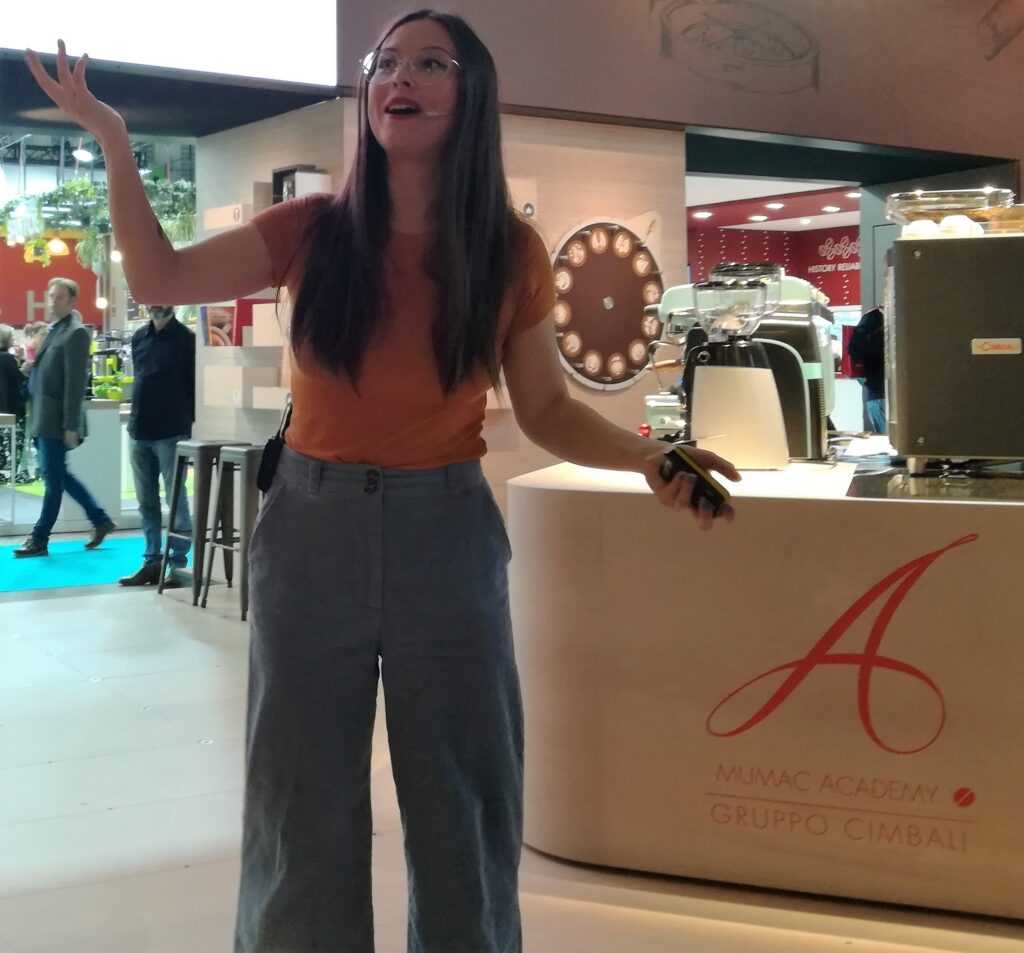MILAN – During HostMilano, Mumac Academy organized a dedicated space to the knowledge of coffee in all its aspects. The third speech around the theme of sustainability and coffee was given by Umeko Motoyoshi, founder of the coffee sustainability platform @wastingcoffee and author of The @WastingCoffee Guide To Not Wasting Coffee, presented by Faema.
She’s also an inaugural member of the 2019 Sprudge Twenty and 2018 recipient of Sprudge’s Outstanding Achievement in the Field of Excellence Award. She began her career as a barista. Currently she’s a full-time coffee writer, educator, and entrepreneur.
During her presentation, Motoyoshi shared about key structural shifts that allow cafes and roasteries to reduce coffee waste while cutting costs and improving quality.
Motoyoshi started her presentation by examining green coffee buying practices.
“Specialty coffee under 86 points is not garbage,” she began.
Then she moved through roasting choices, brewing recipes, training, latte art throwdowns, and more. Basically following the several chapters of her book, she presented information on topics ranging from the cost and quality impact of higher extraction yields to zero-waste latte art throwdowns to the cultivation of mushrooms in coffee grounds. Motoyoshi also talked about helpful practices for implementing new sustainability measures.
From the green coffee to the cup
Through technical aspects such as the Ext (extraction yield) Equation, Motoyoshi explained how to spare coffee during the process of roasting and brewing by considering the solubility factor. How many solid parts of coffee are you wasting in the roasting, extraction, brewing?
The standard equation is (TDS *beverage weight) / (dose – [3.5% * dose]). This formula allows coffee professionals to understand how many solids they’re extracting from their roasted coffee. The extraction yield of a given coffee can be increased by roasting choices in conjunction with intentional brewing conditions. This means you can obtain more batches of coffee beverage without wasting solids left in the coffee grounds.
In other words, with less pounds of coffee you could serve the same number of consumers. Motoyoshi presented an example that showed how a difference of 5% in extraction yield could allow a cafe to serve the same number of customers using 27% less coffee beans.
Motoyoshi then explained some of the main parameters to consider when brewing for high EXT – primarily brew ratio, contact time, grind size, and pump pressure, all factors that correlate with one another. Other variables to consider: bloom time, water temperature, and water chemistry.
The barista must be supported
“Stop blaming baristas,” Motoyoshi said. The expectation of perfect preparation, without correct systems to support that quality, make baristas feel insane. “We must think about systems to help people to succeed. And to feel encouraged to continually improve. We should be teaching confidence and a sustainability mindset.”
The equipment has a role too
Motoyoshi shared about several sustainability features in Faema espresso machines and grinders. The Groundbreaker, as an example, features thermal stability – meaning less grind adjustment, less wasted time, and less wasted shots – and has zero coffee ground retention.
The Smart Boiler reduces energy draw by maintaining more stable temperature and pressure. Energy-Saving Mode allows any of Faema’s independently powered groupheads to be switched off during lower volume or after close, then return to operating temperature in five minutes when switched back on. Finally, Motoyoshi shared that Faema’s boilers are insulated with a material that reduces energy usage by 40%.
What to do about batch brew
Batch brew is another point to optimize. Many cafes throw out batch brew after it sits for more than thirty minutes or an hour. Motoyoshi encourages brewing smaller batches to avoid this waste. She also shared about about difference uses for unserved batch brew, such as using it in baking for cafes that have their own pastry programs.
The twist on the latte art competition
Why throw away so much milk and products in the latte art competition? Motoyoshi shared many ideas to reduce waste at latte art throwdowns. She pointed out that most throwdowns are held at night, when attendees are less likely to want coffee, and shared about hot chocolate throwdowns which address this issue. Hot chocolates can be easily offered to the audience and not to wasted away. It’s only one of the many ideas exposed by Umeko Motoyoshi. All of them are contained in her book.










